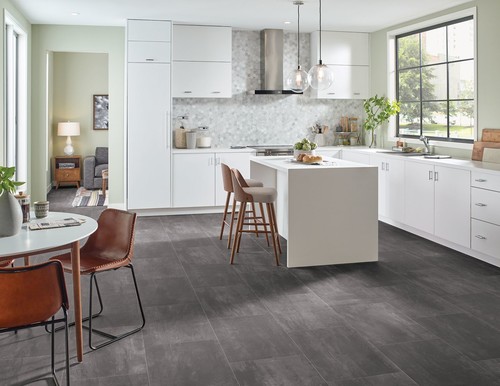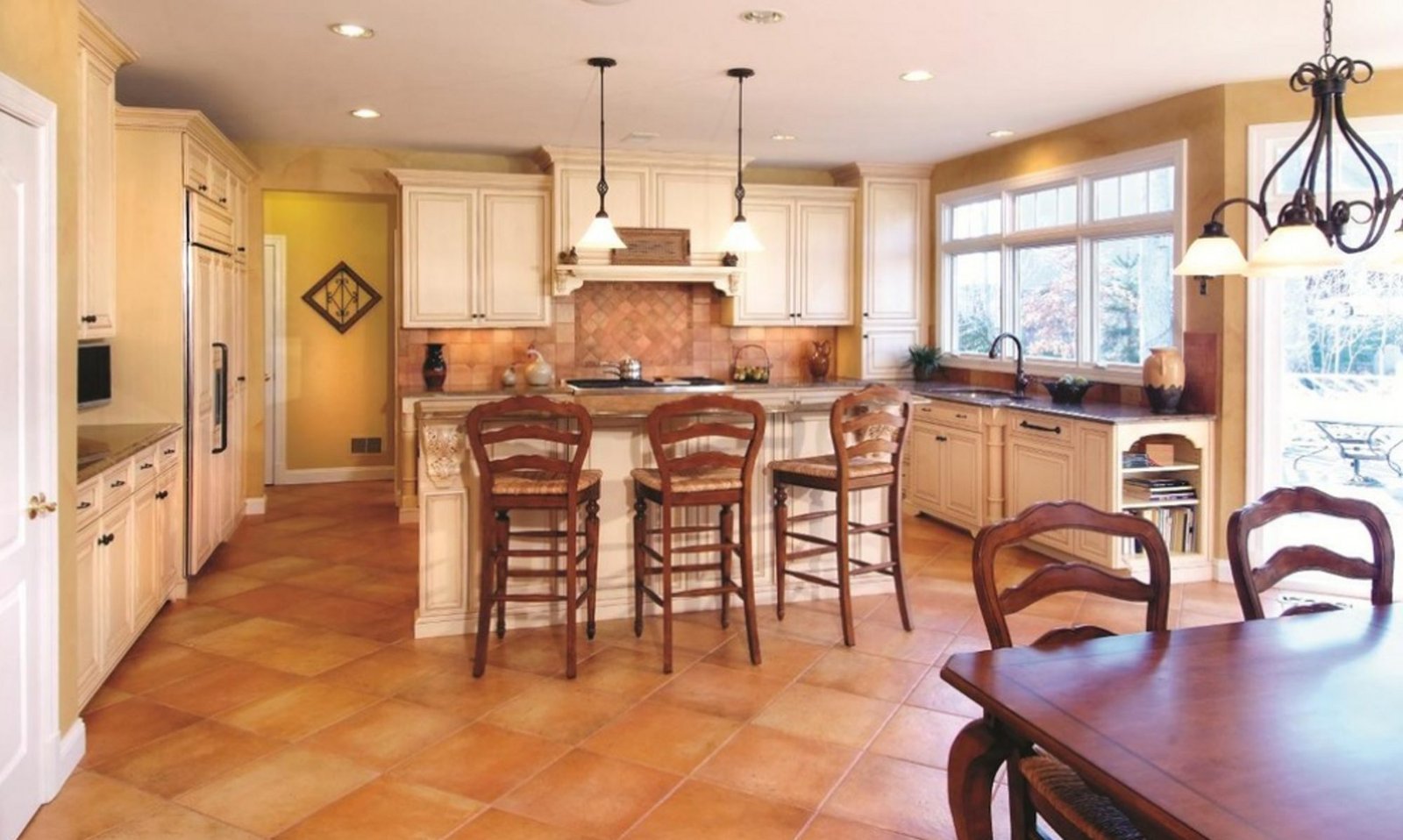I think vinyl sheets and linoleum (lino) remain one of the most popular flooring categories. They are durables and easy to clean. We can find them in every home with children and pets. We won’t have to worry about pet nails or dropped things on these floors. Vinyl sheet flooring is a practical, durable, and an attractive choice for high-traffic areas such kitchen or baths. We can find sheet vinyl or vinyl tile floor and linoleum floor in numerous homes across North America and Europe.

Photo by All About Flooring – Browse kitchen ideas
Vinyl and linoleum resemble each other and although, many persons use the terms vinyl flooring and linoleum flooring interchangeably it is a huge difference between the two. Vinyl is a synthetic material. On the other hand linoleum is 100% natural, an environmental friendly material (biodegradable) made of oil. The name linoleum is from Latin: “linum” (flax) and “oleum” (oil). However vinyl flooring has certain advantages:
1| Linoleum emits fumes, and the air quality is sometime compromised if we are not using low emission adhesive.
2| Vinyl flooring is more durable than linoleum. It is guaranteed not to shrink, expand curl or split.
3| Vinyl is easy to maintain. It is resistant to scuffs and stains.
4| Vinyl is cheaper and is available in a countless styles, patterns and colors.
5| Vinyl is easier to install and water resistant. That it makes it fit for bathrooms, kitchens and areas with high humidity. Highly water resistant means mold and mildew resistant.
6| Vinyl flooring is a good choice for underfoot comfort.
7| Vinyl is noise absorbent more than other hard surface covering.
8| Vinyl is a very hygienic material – very good solution against bacteria.
Vinyl is made from synthetic fibers with the main body made of cardboard or vinyl that is covered with one sheet that contains the motif, another sheet for the finish followed by a protective coat. The motif can be a photo image, or small colored granules. The latest technique gives the finished product an extraordinary hand painted look. The protective coat is very different like thickness and will have a direct bearing on the quality and durability. If the protective coat is thick vinyl sheet or till will be more durable, will resist stains and scratches and of course, will be more expensive. Finish Vinyl sheets and vinyl tiles have two kinds of finish:
1| No-wax finish: Not too glossy appearance and require more maintenance.
2| Urethane finish: Glossy appearance with a more resistance.
How to Install a Sheet Vinyl Floor:
For a handy owner it isn’t too difficult to install the sheet vinyl floor. Generally the sheet vinyl floor is coming in 12 ft. and 6 ft. wide rolls. Only we need is time and patience.
We have to pay attention to the measures and details. Maybe is not a bad idea to make a paper template. First step is to roll out the vinyl sheet and in the same direction with the space. After that, using a tape measure we mark the floor dimensions on the vinyl sheet. For every dimension we need to let 1 or 2 inch extra. Cutting will be easy with a cutter and a straightedge.
The first step in laying any type of roll is preparing the base floor. It must be very smooth and even. If you’re installing the floor covering over a wood floor, plane down all high spots. On a masonry floor, you may need to patch or seal certain sections before laying the floor covering.
Regardless of the type the area has to be cleaned from any dirt and small debris. It will help the adhesive to hold.
The vinyl sheet will be rolled and dry fit to the floor. It’s a good idea to roll one side of the vinyl from outside edge to the center point, leaving the other side flat on the floor.
With a help of a notched trowel we will spread a line of adhesive about a foot wide all along the floor next to the roller flooring. We will work from the center toward the outside edge of the room.
Unrolling will be slowly and in the same time we will press into the adhesive. If we have two pieces of vinyl flooring we will double cut straight through overlapped edges of the two pieces so they fit together perfectly. We will repeat the operation on the same wide area until half of the floor is covered. The surplus of adhesive has to be washed with hot water.
The process will be repeated on the other side of the room.
The trim has to be nailed or glued around the base of the wall. For the edges, that will be covered by the quarter round trim, we may apply staples. Screw down the transition room stripes and the thresholds.
Checking the job done is the last thing, (no air bubbles) and a good idea is to keep a few large scraps for any future repairs.
How to Install a Vinyl Tile Floor:
This kind of flooring was originally produced as an alternative to linoleum and long before the sheet vinyl flooring. In our days vinyl tile flooring is still popular because is colorful, easy to clean and crack resistant and is commonly installed in bathrooms, foyers and laundry rooms. They are easier to install than sheet vinyl floors. They are coming in a large array of colors, textures and patterns. In fact, there are two types of vinyl tiles: glue-down and self-adhesive. Self adhesive tiles seem to be more ideal suited for inexperienced ones who want to lay down this kind of flooring. They are peel and stick product very easy to install. The other ones, glue down is more messy somehow similar with sheet vinyl floor installation.
Installing new underlayment is essential for project success if your existing subfloor is damaged, not level, unsuitable material, or an unsuitable thickness. A minimum subfloor thickness of 3/4 inches or greater in two layers is required. Resilient flooring such as sheet vinyl, linoleum, vinyl composition and asphalt tile can be used as sub-surfaces if they are in good condition and adhered solidly to the subfloor. Vinyl tile can be installed over concrete that is in good condition and structurally sound. Newly poured concrete must cure for a minimum of 28 days before you begin any tile installation. For the old concrete is imperative to sand the old concrete sealers, paint, curing agents. The concrete surface has to be clean and dry.
Installation: First the job site is prepared, cleaned, smooth and flat. Then we need to measure a line from the middle of the room that is parallel to both walls. We doing this because want to start the installation from the middle of the room and work to the walls.
We can install tiles parallel or diagonally with the wall. We need to keep the remaining tiles for future repairs. We do not have to forget is much easier to install tiles when they are warm, softer and more malleable. They will adhere better.
You can cut straight edges in vinyl tiles using a sharp utility knife. After you’ve installed your floor, reinstall your moldings to cover the small gaps at the edges. A new tile floor is an inexpensive way to upgrade any room’s appearance.
How to Install a Linoleum Floor:
Installing linoleum flooring is a good choice if we are looking for an all natural, durable and eco-friendly choice to the vinyl flooring. Linoleum is installed one of three ways depending on the type of linoleum we choose: 1. Sheet Linoleum; 2.Linoleum Tiles; 3 Floating (Click-Lock) Linoleum – panels are clicked and locked together to form a floating floor.
The sheet linoleum installation is similar with sheet vinyl floor installation. Similar the linoleum tiles with vinyl tiles. Floating linoleum is installed much like a laminate floor. To achieve lasting results, be sure the subfloor and any underlayment layers are structurally sound.
Warning: Many adhesives are flammable, cause skin irritation and can produce harmful vapors.
Yellowed Linoleum Cleaning Tips | How To Build A House (howtobuildahouseblog.com)


